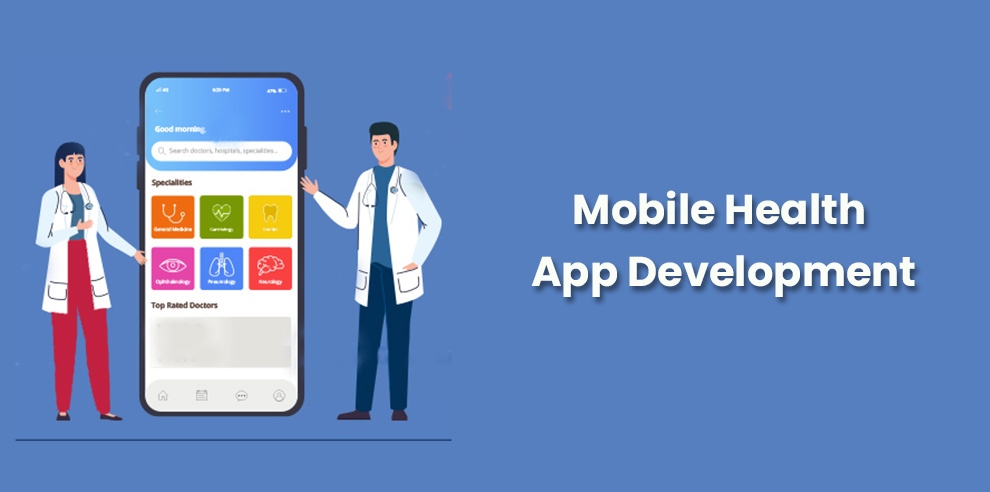Having a study schedule and asking for a tutor’s help can do wonders to your academic performance.
The first thing you must decide is whom are you catering to and what is the gap that you are trying to fill with your app. Then make sure to study the market competition before building your app.
A Statista report has projected revenue in the healthcare industry to reach $17.03 billion in 2023. The industry has tentacles and can be broken into different markets.
Each market houses different businesses, and the industry connects with alternative industries like self-care, wellness, and mental health.
Building a health app within this huge market can become a no-brainer, especially if your market research suggests your product resonates with potential buyers. Let’s explore how to build a medical app.
Unlike what many people think, building, launching, and rolling out a successful service offering or application is a core-marketing nightmare.
It is true that the developers (front-end and backend), testers, and UI/UX experts are thoroughly involved with the project. Still, the app’s success largely depends on the startup’s ability to identify an underserved market and explore the potential of the loopholes within the market.
This article will explore the marketing and technical aspects of mobile health app development (according to the relevant Topflight Apps’ research).
Technical Consideration When You Want to Create a Medical App
There are many medical apps in the market, with each popular app serving unique pain points. In a broad spectrum, we have:
A. Apps that connect patients with medical professionals (with stronger ease on the medical professionals):
These apps help medical professionals or doctors reserve appointments, automate payments, cancel appointments, and hold live and remote sessions with prospective and non-prospective patients.
The strong suit of an app like this is its ability to streamline the communication between a prospective patient and a doctor, basically removing the hassle a patient will go through to get a medical doctor.
A real-life scenario is when a patient in Scotland can book a remote appointment with a medical doctor in the United States to look at his body and probably diagnose sclerosis.
B. Apps that help patients find hospitals within their locale:
It’s bad enough to be sick, but the sickening search for a specialist can weigh down a patient. Medical apps connect hospitals to prospective patients (and vice versa), helping patients search for the appropriate medical facility or healing center for a particular illness.
A patient looking for a diagnostician in Alabama can use such an app to get a list of hospitals with diagnosticians in the state and connect with the right hospital.
Such apps will have ratings, reviews, and other elements to help a patient make the best decision.
How to Build a Medical App: Niche Down Your App
Again, the healthcare industry is enormous and has different markets, with each market comprising many business openings. When building a healthcare app, you must be able to answer three questions:
1. Why am I to build healthcare applications?
Defining the reason behind a service offering or a product will help you focus on the market’s potential instead of the product’s.
Marketing focuses on the market first and defines why the product fits the market well. If you build a healthcare app because everyone is building one, the app will fail.
2. Who am I building the app for?
In mobile health app development, you must know your target audience. Have you built a prototype and sent it to hospitals to get feedback? Do people need your mobile application?
Remember that technology is meant to simplify people’s lives. And if it does not simplify your prospective customers’ lives, it should add some luxurious value that is not found elsewhere. Is there a massively underserved market that can use your product?
3. Is there competition
What is your competition like? It’s hard to come from behind and topple the number one or two within a market space or industry. You need to determine the position you would like your application to hold.
For example, there are healthcare applications with smaller subscribers that earn a decent income because they offer special auditing and tracking services to already-established companies.
So, your app can target incredibly rich medical practitioners who want to remain private while conducting business and connecting with ultra-wealthy clients. Competition is a significant worry when learning how to build a healthcare app.
What to Consider When Building a Healthcare App
Funding: You should consider the funding needed to push your app through from concept to product launch. While you may not get all the funding needed in the beginning phase, you should always plan ahead to prevent sudden halts or stops in the middle of the project.
Talent: When learning how to build a medical app, you should know that mobile application development revolves around leading different talents to create something truly incredible.
Of course, experience in the mobile application development industry is an added advantage, but even without such experience, you can always hire the best talent your money can buy, create a plan, and execute.





